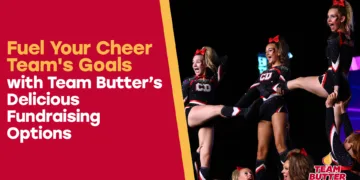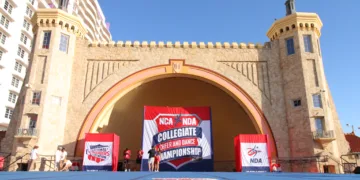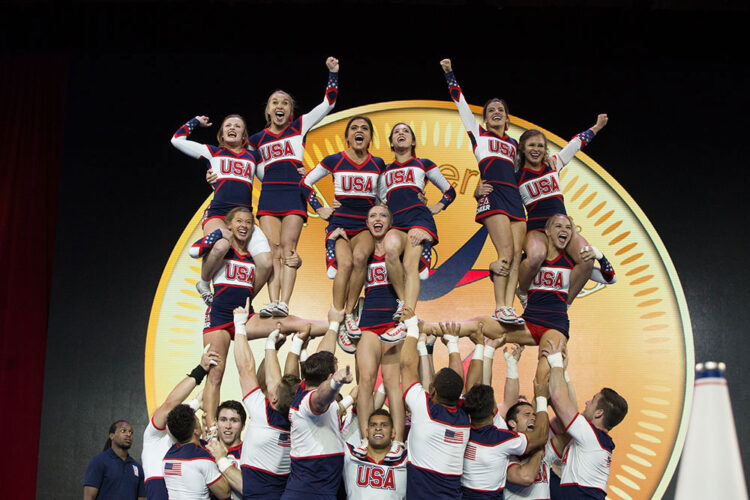Cheerleading is often the subject of debate—dismissed by some as mere sideline entertainment while fiercely defended by those who truly understand the depth of athleticism and dedication it demands. The misconceptions about cheerleading couldn’t be further from the truth.
Far from the peppy, pom-pom-waving stereotypes often portrayed in the media, cheerleading is a high-intensity, physically demanding sport that pushes athletes to their limits and beyond. The physical and mental challenges are immense, requiring cheerleaders to train tirelessly, perform complex routines under immense pressure, and do it all with a smile. The lack of recognition and respect cheerleaders face is disheartening, but those who step onto the mat know the truth.
Cheerleading is not for the faint-hearted. It’s a sport that requires an extraordinary level of skill, strength, and perseverance. Here are 10 reasons why cheerleading stands out as one of the hardest sports in the world.
1. Extensive Gymnastics and Tumbling Experience
Cheerleading demands a high level of gymnastics and tumbling ability. Most high school cheer teams require at least a back handspring for consideration. Gymnasts often transition to cheerleading, incorporating their tumbling, jumps, and precision.
Mastering skills like back handsprings, back tucks, and fulls can take years. The training regimen for these skills is rigorous, involving countless hours in the gym perfecting technique and building the necessary strength and flexibility. Cheerleaders often start tumbling at a young age and continue to refine their skills throughout their careers. The physical demands are immense, and the risk of injury is ever-present, making the mastery of these skills a true testament to a cheerleader’s dedication and athleticism.
2. Comparatively Low Injury Rates with Significant Improvements
While cheerleading has been known for its high injury rates, recent data shows a significant decrease in injuries due to improved safety measures and training protocols. According to the National Center for Catastrophic Sport Injury Research (NCCSIR), cheerleading has experienced a major reduction in injuries since 2010. In 2019-2020, there were zero reported catastrophic injuries, and only three in the past five years. This is comparable to other girls’ high school sports and lower than football, baseball, wrestling, girls’ soccer, and girls’ track & field.
These improvements underscore the effectiveness of enhanced safety regulations and better coaching, making cheerleading a safer sport while still demanding high levels of physical performance.
3. Intense Time Commitment
Cheerleaders often practice five days a week, with games and competitions on weekends. Practices can last up to four hours, and summer cheer camps consume even more time. This intense schedule leaves little room for a social life, highlighting the commitment required.
The time commitment also extends beyond regular practices. Cheerleaders often spend additional hours conditioning, attending tumbling classes, and perfecting their skills outside of team practice. Competitions require travel and often involve entire weekends dedicated to performing, supporting other teams, and participating in team-building activities. Balancing schoolwork, cheerleading, and personal life is a challenging feat, demonstrating the dedication cheerleaders must have to succeed in the sport.
4. Significant Financial Investment
Competitive cheerleading is a significant financial commitment, with reported costs ranging as high as $15,000 per year. This includes expenses for the season, competitions, uniforms, warm-ups, bows, jackets, and shoes. Travel to prestigious competitions in places like Walt Disney World and traveling to over 10 cheerleading competitions per year adds to the financial burden.
Families often have to budget carefully to afford the costs associated with competitive cheerleading. Fundraising efforts are common, with teams organizing events and seeking sponsorships to help cover expenses. Despite the financial challenges, many families willingly invest in cheerleading because of the benefits it offers, such as building teamwork, discipline, and a strong work ethic.
5. Rigorous Competitions
Competitions are the highlight for many cheerleaders. Teams spend countless hours perfecting routines to ensure flawless performances. Competitions are highly competitive, with hundreds or thousands of teams vying for first place. Every mistake is scrutinized, making precision crucial.
The competitive atmosphere is intense, with teams performing complex routines that include stunts, tumbling, jumps, and dance. Judges evaluate each aspect of the performance, looking for synchronization, technique, and overall execution. The pressure to perform perfectly is immense, and the emotional highs and lows of competition season are a significant part of a cheerleader’s experience. Winning a competition is a testament to a team’s hard work, coordination, and perseverance.
6. Demanding Physical Conditioning
Cheerleading requires exceptional strength, cardio, and conditioning. Practices include push-ups, sit-ups, stretches, and running to build endurance. During a routine, cheerleaders perform high-intensity activities without breaks, requiring immense stamina. Missing a tumbling pass or failing a stunt can mean the difference between winning and losing.
Conditioning is a year-round commitment for cheerleaders. Off-season training focuses on building strength and endurance, while in-season practices are designed to maintain peak physical fitness. The physical demands of cheerleading routines, which last for 2 minutes and 30 seconds, are comparable to those of high-intensity interval training. Cheerleaders must be in top physical condition to perform at their best and minimize the risk of injury.
7. Advanced Stunts Require Skill, Strength, and Flexibility
Cheerleading stunts demand incredible skill, strength, and flexibility. Partner stunting, for example, requires flyers to be perfectly balanced and bases to have substantial upper body strength. Even a slight mistake can lead to serious injuries, underscoring the precision needed.
Stunts are choreographed to showcase the athleticism and creativity of the team. Flyers perform intricate maneuvers while being lifted and thrown by bases, who must remain stable and coordinated. Flexibility training is essential for flyers to execute one-legged stunts like heel stretches and scorpions. The trust and communication between team members are paramount, as any lapse in focus can result in injury. The complexity of stunts continues to evolve, with teams constantly pushing the boundaries of what is possible.
8. Dance Experience and Precision
Cheer dance integrates elements of various dance styles, requiring natural ability and extensive practice. Every motion must be synchronized, and teams spend hours perfecting their routines to ensure uniformity. This level of detail is essential for competitive success.
Dance routines in cheerleading require precise timing and coordination. Teams practice counts meticulously to ensure that every movement is executed in perfect unison. The incorporation of jumps, spins, and floor work adds to the complexity, demanding a high level of skill and athleticism. The visual appeal of a well-synchronized dance routine is a key component of a successful performance.
9. Emerging as a Top Competitor: World Games and Olympic Aspirations
In a landmark decision at the Annual General Meeting in Esslingen, Germany, the International Cheer Union (ICU) has been officially welcomed into The World Games family. This vote marks a significant recognition of cheerleading as a sport, alongside the inclusion of flag football, showcasing the growing diversity of The World Games.
The decision followed meticulous reviews of the applications by the IWGA members, culminating in a vote that officially recognized cheerleading and flag football as part of the upcoming Chengdu 2025 sports program. While Flag Football returns after its invitational appearance at Birmingham in 2022, the upcoming event will mark cheerleading’s inaugural competition at this level, spotlighting its dynamic blend of dance, acrobatics, and spirited teamwork.
The World Games (TWG) is a multi-sport event held every four years, featuring around 35 sports in its program. Cheerleading, fully recognized by the International Olympic Committee (IOC) in 2021, has seen exponential growth, governed globally by the ICU. The sport combines elements of dance and acrobatics with spirited chants to boost team morale and entertain spectators. Its acceptance into The World Games is a testament to the dedication of millions of cheer athletes, coaches, officials, national federations, and enthusiasts worldwide.
ICU President Jeff Webb highlighted the significance of this milestone, stating, “ICU’s acceptance into the IWGA family as full members is an incredible achievement for the global cheer community. We are committed to delivering an incredible event in Chengdu and in future editions of The World Games for years to come.”
This recognition not only marks cheerleading’s progress but also fuels aspirations for its inclusion in future Olympic Games, potentially as soon as the 2032 Brisbane Olympics. This journey reflects the sport’s evolution and the dedication of its athletes and advocates.
10. Overcoming Lack of Respect
Cheerleaders often face stereotypes and a lack of respect. Despite the rigorous training and dedication, many people don’t recognize cheerleading as a sport. This social pressure adds to the stress of an already demanding activity. The portrayal of cheerleaders in media doesn’t help, often reinforcing false stereotypes.
Cheerleaders work tirelessly to change public perception and gain the recognition they deserve. The cheerleading community supports each other, celebrating achievements and advocating for the sport. Overcoming societal misconceptions requires resilience and a strong sense of identity, qualities that cheerleaders embody through their dedication and passion for the sport.
Understanding the Two Categories of Cheerleading
Cheerleading can be categorized into two distinct types: spirit squads and competitive cheerleading. Each category has unique characteristics, demands, and roles within the sport. As cheerleading continues to grow exponentially worldwide, the lines between these categories are increasingly blurring, with competition elements bleeding into traditional spirit squads.
Spirit Squads
Spirit squads are the traditional form of cheerleading, where students cheer for school sports teams. While their routines can be physically demanding, these cheerleaders typically do not compete. Their primary role is to support their school’s teams by leading chants, performing during halftime, and promoting school spirit.
According to a 2008 “Dear Colleague” letter from the Department of Education Office for Civil Rights (OCR), spirit squads are not considered sports for Title IX purposes. This classification means they do not receive the same resources or recognition as other sports teams. However, spirit squads are integral to the game-day experience, providing energy and enthusiasm that enhances the atmosphere at sporting events.
As cheerleading evolves, competition elements are increasingly being incorporated into spirit squads. This trend is exemplified by events like the National High School Cheerleading Championship, produced by Varsity Brands. This championship, first held in 1980, was created to reward cheerleaders for their work on the sidelines and to create a venue where they could be recognized for their talents and abilities.
The National High School Cheerleading Championship has been featured on ESPN since 1983, bringing the competition to hundreds of millions of homes. This year’s event hosted 1,183 teams from 34 states. Teams competing at the championship must qualify at regional competitions and are credentialed in cheer safety and leadership training, endorsed by the National Federation of High School Sports (NFHS).
Teams are judged on their stunting and tumbling skills, crowd-leading ability, and overall performance. The championship includes divisions like Traditional Routine, Game Day, and the newest division, Game Day Live, which allows cheer teams to perform with their school’s band members in a live performance setting, translating their traditions from the sidelines to the competition floor. This integration of competition into spirit squads underscores the dynamic evolution of cheerleading and its growing recognition as a competitive sport.
Competitive Cheerleading
Competitive cheerleading, also known as STUNT or competitive spirit, merges gymnastics, cheer, and dance into a highly disciplined team event that often requires year-round training. Teams compete in regional, state, and national events for prestigious awards. In the 2021-22 school year, over 100,000 high school students participated in competitive cheer.
This form of cheer may be considered a sport for Title IX purposes, with the OCR making determinations on a case-by-case basis. Efforts are ongoing to recognize competitive cheer as a sport at the national level, particularly in high schools. In 2016, the International Olympic Committee (IOC) designated cheerleading as a sport and assigned a national governing body. As of the 2021-22 school year, 30 states recognized competitive spirit as a sport, according to the National Federation of State High School Associations (NFHS) Participation Survey.
At the collegiate level, over 300 colleges in the United States compete at UCA College Nationals and NCA College Nationals. These events showcase the athletic prowess and dedication of cheerleaders from across the country. Powerhouses like Morehead State University exemplify the high level of competition, with Morehead State winning an impressive 54 overall national championships at UCA College Nationals since they began competing in 1988. Despite the lack of NCAA recognition, collegiate cheerleading continues to thrive, highlighting the rigorous training, skill, and teamwork required to excel at this level.
As of April 2024, the International Cheer Union (ICU) estimates that there are 7.5 million cheerleaders in 116 member nations worldwide. In the United States alone, over 3 million cheerleaders participate in youth, all-star, school, and STUNT cheerleading. In 2023, approximately 3.8 million Americans aged six and older participated in cheerleading.
Cheerleading, whether through spirit squads or competitive cheerleading, demands immense physical and mental dedication. Each category offers unique challenges and opportunities, contributing to the sport’s dynamic and multifaceted nature. The evolution of cheerleading into a recognized sport by the IOC and its inclusion in prestigious competitions like The World Games reflect its growing legitimacy and the relentless dedication of its athletes and advocates. As competition continues to bleed into spirit squads, cheerleading is poised to further its reach and impact, solidifying its status as a formidable sport on the global stage.
Understanding Cheerleading Safety Data and Research
National Center for Catastrophic Sport Injury Research (NCCSIR)
Data from the National Center for Catastrophic Sport Injury Research shows that cheerleading has experienced a major reduction in injuries since 2010. This is due to additional rules, restrictions, and improved coach training. Research indicates that cheerleading is a safe activity for athletes of all ages.
In 2019-2020, there were zero reported catastrophic injuries in cheerleading, and only three reported in the past five years. The number of catastrophic injuries from cheerleading over the past five years is similar to other girls’ high school sports and lower than football, baseball, wrestling, girls’ soccer, and girls’ track & field.
High School RIO Data
The 2020-21 High School RIO Study shows that cheerleading ranks 18th out of 20 high school sports for overall injuries and 10th for concussion rates, below other female sports like soccer and basketball.
Consumer Products Safety Commission Emergency Room Reports (NEISS)
According to the Consumer Products Safety Commission, in 2022, there were fewer emergency room visits for girls ages 12-18 for cheerleading (18,007) than for girls’ basketball (36,174), soccer (33,082), volleyball (25,942), and softball (22,690).
National High School Sports-Related Injury Surveillance Study
This annual study, conducted for the National Federation of High Schools, includes reporting by Athletic Trainers at the high school level. Results demonstrate that cheerleading has a significantly lower risk of injury, ranking 17th out of 20 sports.
National Electronic Injury Surveillance System (ER Visits)
This report estimates total injuries based on data from emergency rooms across the U.S. Cheerleading has a lower number of ER visits (7,457) than girls’ basketball (27,097), soccer (16,159), volleyball (11,248), and softball (11,176) for females aged 14-18.
Trends in Concussion Incidence in High School Sports: A Prospective 11-Year Study
This 10-year study reported that cheerleading is tied with baseball for the lowest concussion rates (.06 per AE), compared with higher rates in sports like boys’ football (.60), girls’ soccer (.35), and boys’ lacrosse (.30).
Incidence and Risk Factors for Concussion in High School Athletes, North Carolina, 1996–1999
This study evaluated 15,802 high school athletes over a three-year period. It demonstrated that the rate of concussion in cheerleading is significantly less than in other high school sports, tying with wrestling for the lowest concussion rates.
Reducing Injuries and Liability in Cheerleading
To minimize injuries and potential liability, it’s essential to allocate appropriate resources to cheerleading programs and adhere to safety guidelines. Here are key steps to enhance safety:
- Implement New Rules
The NFHS annually revises cheer team rules to create safer environments. Recent changes include increasing human supports for inverted stunts and banning hard or sharp props during stunts. - Create an Emergency Action Plan
Develop plans that include concussion management. Refer to resources such as Athletics Emergency Action Plans for guidance. - Develop a Return-to-Play Protocol
Use USA Cheer’s concussion guidelines and return-to-play recommendations to prevent traumatic brain injuries. - Implement Waivers
Create sport-specific waivers that list potential injuries. - Conduct Preparticipation Medical Examinations
Preparticipation evaluations establish a standard of health and identify athletes who may be at increased risk of harm. - Train Cheerleaders to Follow Safety Guidelines
Provide proper conditioning programs and training in spotting techniques and stunts. - Require Safety Certification of Cheerleading Coaches
Organizations such as the American Association of Cheerleading Coaches and Administrators, now part of USA Cheer, offer coach training and certification. - Use Safety Equipment and Personnel
Ensure the use of adequate matting and spotters at all practices and events. - Supervise All Practices and Events
Supervisors should provide immediate medical attention to cheerleaders who suffer injuries or show signs of head trauma.
By following these guidelines, cheerleading programs can significantly reduce the risk of injuries and associated liabilities, ensuring a safer environment for all participants.
Cheerleading, whether through spirit squads or competitive cheerleading, is a dynamic and demanding sport that pushes athletes to their limits. It combines the thrill of high-flying stunts, the precision of gymnastics, and the energy of dance, all performed under intense pressure and scrutiny. As the sport continues to grow and evolve, with competitions and collegiate powerhouses like Morehead State University setting new standards, cheerleading is solidifying its place as a formidable and respected sport on the global stage.
The relentless dedication, immense physical and mental strength, and unwavering team spirit required for cheerleading highlight its true nature. It’s more than just cheering from the sidelines; it’s about pushing boundaries, breaking barriers, and achieving excellence. As cheerleading continues to gain recognition and popularity worldwide, it’s clear that this sport is here to stay, inspiring a new generation of athletes to reach for new heights.
Do you agree? Join the conversation and share your thoughts on why cheerleading deserves recognition as the toughest sport.






















